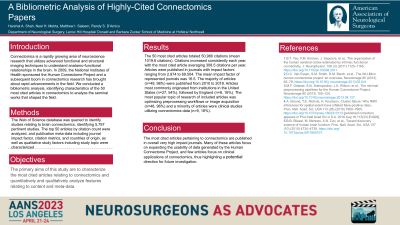A Bibliometric Analysis of Highly-Cited Connectomics Papers
A Bibliometric Analysis of Highly-cited Connectomics Papers
Friday, April 21, 2023


Harshal A. Shah (he/him/his)
Medical Student
Donald and Barbara Zucker School of Medicine at Hofstra/Northwell
Boyds, Maryland, United States
ePoster Presenter(s)
Introduction: Connectomics is a rapidly growing area of neuroscience research that utilizes advanced functional and structural imaging techniques to understand anatamo-functional relationships in the brain. In 2009, the National Institutes of Health sponsored the Human Connectome Project and a subsequent boom in connectomics research has brought about rapid advancements in the field. We conducted a bibliometric analysis, identifying characteristics of the 50 most cited articles in connectomics to analyze the seminal works that shaped the field.
Methods: The Web of Science database was queried to identify studies relating to brain connectomics, identifying 5,797 pertinent studies. The top 50 articles by citation count were analyzed, and publication meta-data including journal impact factor, citation metrics, and countries of origin, as well as qualitative study factors including study topic were characterized.
Results: The 50 most cited articles totaled 50,980 citations (mean 1019.6 citations). Citations increased consistently each year, with the most cited article averaging 308.5 citations per year. Articles were published in journals with impact factors ranging from 2.974 to 69.504. The mean impact factor of represented journals was 16.5. The majority of articles (n=49, 98%) were published from 2010 to 2018. Articles most commonly originated from institutions in the United States (n=27, 54%), followed by England (n=8, 16%). The most popular topic of research of included articles was optimizing preprocessing workflows or image acquisition (n=24, 48%) and a minority of articles were clinical studies utilizing connectomics data (n=9, 18%).
Conclusion : The most cited articles pertaining to connectomics are published in overall very high impact journals. Many of these articles focus on expanding the usability of data generated by the Human Connectome Project, and few articles focus on clinical applications of connectomics, thus highlighting a potential direction for future investigation.
Methods: The Web of Science database was queried to identify studies relating to brain connectomics, identifying 5,797 pertinent studies. The top 50 articles by citation count were analyzed, and publication meta-data including journal impact factor, citation metrics, and countries of origin, as well as qualitative study factors including study topic were characterized.
Results: The 50 most cited articles totaled 50,980 citations (mean 1019.6 citations). Citations increased consistently each year, with the most cited article averaging 308.5 citations per year. Articles were published in journals with impact factors ranging from 2.974 to 69.504. The mean impact factor of represented journals was 16.5. The majority of articles (n=49, 98%) were published from 2010 to 2018. Articles most commonly originated from institutions in the United States (n=27, 54%), followed by England (n=8, 16%). The most popular topic of research of included articles was optimizing preprocessing workflows or image acquisition (n=24, 48%) and a minority of articles were clinical studies utilizing connectomics data (n=9, 18%).
Conclusion : The most cited articles pertaining to connectomics are published in overall very high impact journals. Many of these articles focus on expanding the usability of data generated by the Human Connectome Project, and few articles focus on clinical applications of connectomics, thus highlighting a potential direction for future investigation.
